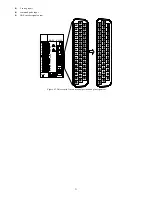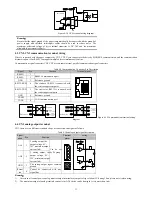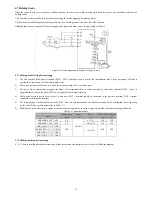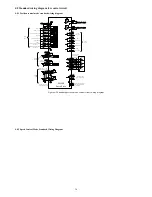
26
DC5V~24V
NPN
relay
Servo drive
DO1
DO1-
8
37
When using internal power supply
25 +24V
COM
22
NPN
relay
Servo drive
DO1
DO1-
8
37
25
22
Figure 4-10(a) Correct digital input wiring when host device is relay output
NPN
DC5V~24V
DO1
DO1-
Relay Not
Accessed
8
37
25
22
NPN
Relay
Servo drive
DO1
DO1-
8
37
25
+24V
COM
22
Wrong polarity
of freewheeling
diode
Servo drive
Figure 4-10(b) incorrect digital input wiring when host device is relay output
Remark
:
When the host device is relay input, make sure to access the freewheeling diode, or it may damage the DO port.
2) When the host device is optocoupler input
NPN
DC5V~24V
Servo drive
DO1
DO1-
8
37
NPN
Servo srive
DO1
DO1-
8
37
Using internal power supply
Using external power supply
25 +24V
COM
22
25
COM
22
External power
supply ground
Figure 4-11(a) correct digital input wiring when the host device is optocoupler input
NPN
DC5V~24V
Servo drive
DO1
DO1-
8
37
NPN
DO1
DO1-
8
37
When using internal power supply
When using external power supply
25
+24V
COM
22
25
COM
22
Not connected with
current limit resistor
Not connected
with current
limit resistor
External power
supply ground
Servo drive
Figure 4-11(b) incorrect digital input wiring when the host device is optocoupler input
Remark
:
The maximum allowable voltage, current capacity of servo drive internal optocoupler output circuit is as followed:
Voltage
:
DC30V(maximum)
Current: DC 50mA
(maximum)
If driving the inductive loads (relay, contactor), a surge voltage absorption circuit should be added; such as RC absorption circuit (the
leakage current should be less than the holding current of contactor or relay) varistor, or freewheeling diode (for DC circuit, check the
polarity during installation). The element of snubber circuit should be closed to the relay or contactor.
4.4.7 CN4 analog input terminal wiring
Table 4-4 analog input terminal description
Signal name
Function
Pin
Function describe
Analog
AI1
15
Voltage analog input
AI2
30
















































